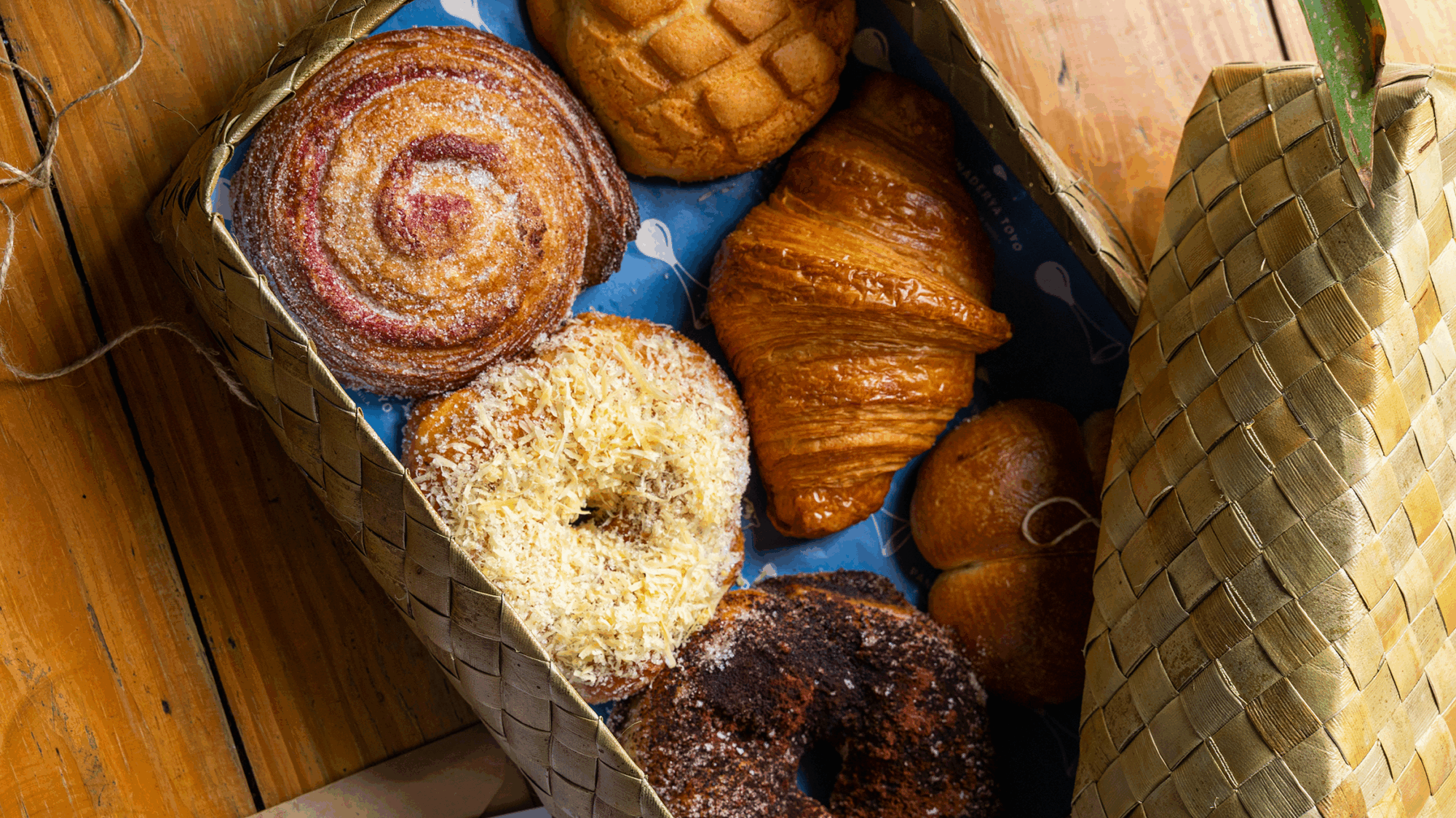
A new generation of Filipino bakers and entrepreneurs are establishing a café culture that is authentically their own.
Wherever there are Filipinos, there are Filipino bakeries. In the Philippines, panaderyas are an essential source of sustenance for the everyday working class, providing people with their daily bread: pandesal. The pillowy, mildly sweet, breadcrumb-coated yeasted bread rolls—best dunked in a hot cup of coffee for breakfast or tsokolate (hot chocolate) for meryenda (snack time)—are the lifeblood of these establishments. In Little Manilas from Dubai to Daly City, California, mom-and-pop bakeries and major chains like Goldilocks are essential mainstays, serving immigrants pandesal and other classics like light and fluffy mamon, pan de coco filled with sweetened shredded coconut meat, and golden, deep-fried bicho-bicho.
Since Spanish colonizers brought bread to the Philippines in the 16th century, generations of bakers have created their own core bakery essentials like airy mamons and empanadas stuffed with tender shredded meat and vegetables. Now a younger generation of bakers and entrepreneurs are shaping a Filipino baking tradition of their own—pushing not just the boundaries of flavor and form but what it means to be “authentically Filipino,” both in the United States and abroad.
Within just the past year, several Filipino cafés have opened to much fanfare in California, New York, New Jersey, and Chicago. Bakery freaks wait in lines that extend out the door and wind around the block. Jumping out of the pastry case? Brioche doughnuts with a beautifully glossy leche flan embedded at the center at Kora in New York, croissants stuffed with longganisa at Del Sur Bakery in Chicago, and chicken sisig kolaches at Panaderya Salvajē in Jersey City, with violet-hued ube lattes to wash them all down.
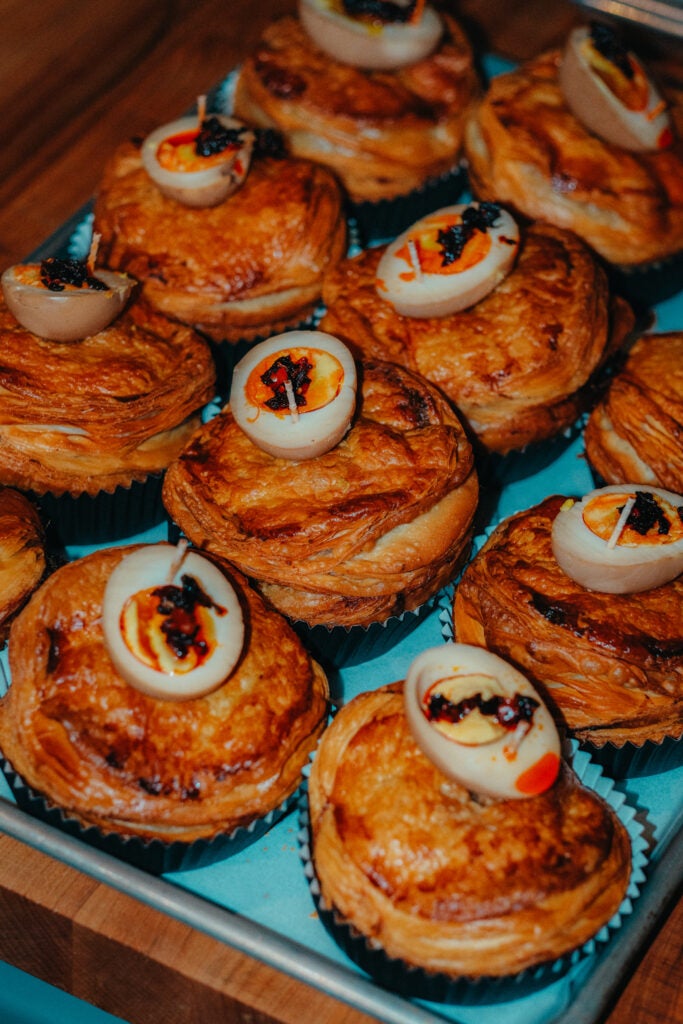
Dinakdakan Pot Pie at Panaderya Salvajē. Photo: Ian Somosa
“I think the term ‘Filipino bakery’ has gone from this idea of a traditional bakery to what ‘Filipino’ means to you and to me,” says Justin Lerias, pastry chef and owner of Filipino Midwestern bakery Del Sur in Chicago. “Del Sur is pretty much directly inspired by my immigrant story.”
Lerias was born and raised in the southern Philippines region of Zamboanga del Sur and moved to Chicago with his family when he was 14 years old. As he was taught to assimilate to American culture, he questioned whether he was really Filipino or American. Del Sur is his way of saying that, actually, it’s okay to be both. His menu includes bay leaf–infused adobo brownies made with a soy sauce caramel and black pepper garnish, a turon-inspired caramelized banana Danish, and a vibrant pandan Basque cheesecake.
A big part of what encouraged Lerias to open his bakery is the now-thriving Filipino culinary scene in the United States, particularly in Chicago, a city that has been home to Filipino communities for over 120 years and that has the world’s first Michelin-starred Filipino restaurant and bakery, Kasama, which was opened by Timothy Flores and Genie Kwon in 2020. Plus, within just a one-mile radius of Del Sur, there’s a whole roster of Filipino-owned joints, including restaurants like Boonie’s, Bayan Ko, and Kanin, as well as specialty coffee shop Side Practice.
Lerias also feels a kinship with Kora in New York. He frequently chats with co-owner and head chef Kimberly Camara about the business of running a Filipino bakery, exchanging stories and tips. Like Del Sur, Kora began operating out of an apartment during the COVID-19 pandemic. At one point, more than ten thousand people were on a waiting list for a box of Kora’s Filipino-inspired doughnuts in flavors like ube, leche flan, and buko pandan. With the opening of their first brick-and-mortar location in Sunnyside, Queens, in 2025, Camara and her cofounder / head of operations Kevin Borja have been able to expand their offerings to savory bakes, laminated pastries, and more.
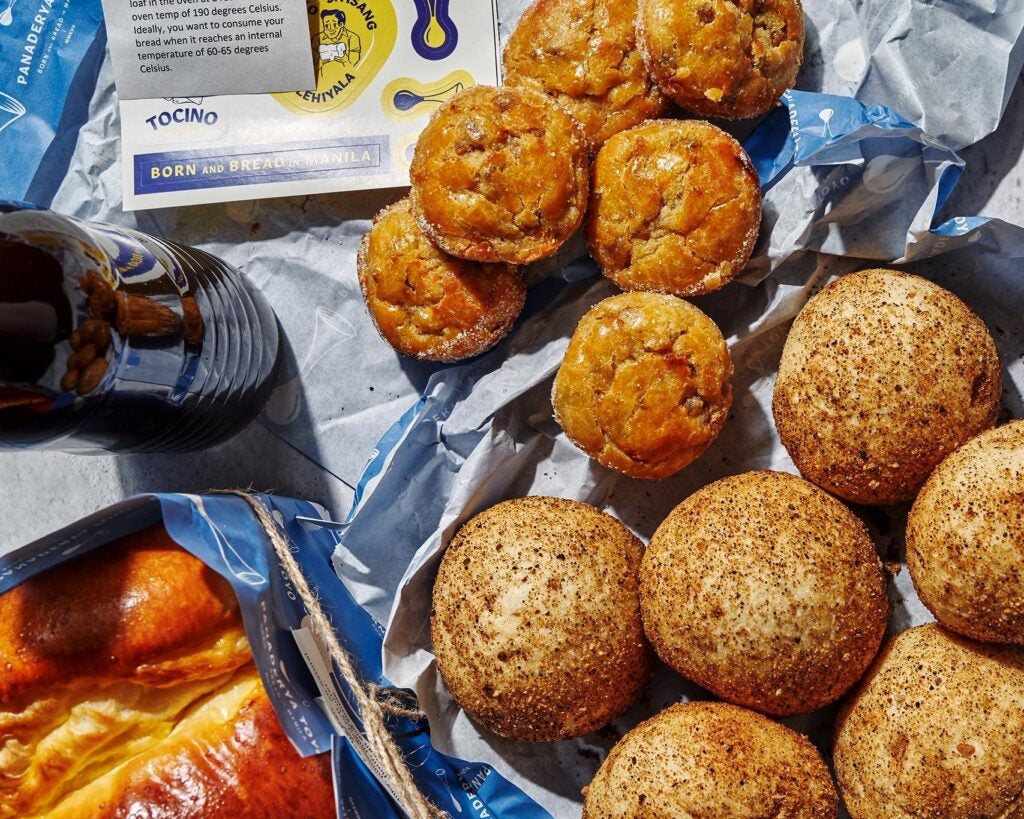
Toyo leche pan, pandesal, and tocino bread at Panaderya Toyo. Photo: Miguel Nacianceno
As someone who was born in the Philippines and raised eating pandesal from local bakeshops for breakfast, I’d be lying if I said I didn’t initially question the hype around this new style of Filipino baking, which I’ve seen spring up in cafés in the motherland as well. However, all my doubts were put to rest when I bit into Kora’s tangy-sweet apple tamarind fritter. The soft crunch of the thick fried, fruity batter took me back to hot and humid afternoons in my small rural hometown in the Philippines, happily snacking on maruya (banana fritters) after coming home from school.
“We’re not making pandesal, but we’re calling ourselves a Filipino-inspired bakery,” says Camara. As a Filipino born and raised in New York, Camara has even been toying with the idea of eventually making Filipino pizza. “It’s completely authentic to who we are and to who I am as a chef and what I’ve experienced.”
This question around authenticity has haunted (and still haunts) many a Filipino chef—with Filipinos being their toughest critics. However, the point of these places isn’t to please every tita and tito. These cafés reflect a generational shift in the diaspora, from older Filipino immigrants who seek the comforts of the home country they left behind to young immigrants and the second generation who are trying to build something new for themselves.
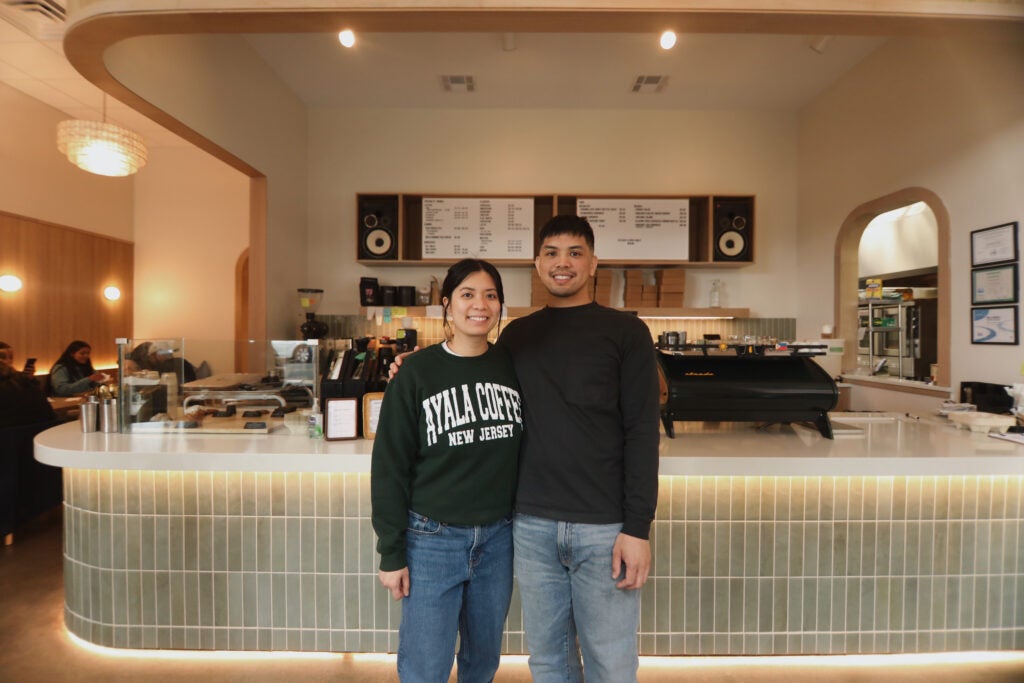
Ayala Coffee co-owners Trixie Jose and Matthew Reyes. Photo: Cat Lee
Aside from the desire to brew and serve coffee directly sourced from the Philippines, a big part of why Trixie Jose and Matthew Reyes opened Ayala Coffee in Union, New Jersey, is to recreate the feeling of community that their parents had in old-school Filipino establishments. The town of Union, and New Jersey in general, has a sizable Filipino American population, and therefore a lot of restaurants run by titos and titas.
Jose recalls going to these places occasionally to grab lunch and often seeing her mom’s friends. “But I would hardly ever see people my age going there just to hang out,” she says. So she and her husband opened the doors to Ayala Coffee in 2024 with the intention of providing a third space for younger Filipinos. “Part of our goal was to capture the lens of our generation with Filipino flavors in a way that is approachable,” adds Reyes.
Nicu Dalman, chef and co-owner of Panaderya Salvajē in Jersey City, translates regional Filipino dishes into more familiar foods. He’s turned dinakdakan, a grilled pork face dish from Ilocos, into a pot pie and made beef kaldereta into a pain Suisse, based on a recipe from his father’s hometown in Bukidnon. However, when it comes to piaya—a flatbread that vendors in his native Bacolod roll out fresh to order—the only modification he’s made is to use butter instead of shortening. “It’s a preference,” he laughs. “Because shortening? I don’t like the smell.”
Personally, I’m most excited for the promise of Dalman’s sourdough. Like the precolonial Filipino ancestors, he plans on using an alcoholic beverage made from fermented palm tree sap called tubâ as a raising agent instead of yeast.
In London, where sandwiches are the lunchtime staple, Filipino bakery and coffee shop Panadera makes them with slices of chef and owner Florence Mae Maglanoc’s special pandesal loaf. This unique take on the Filipino daily bread is the result of 20 years of mastering the yeasted dough, having learned the method firsthand from her mother starting as an eight-year-old growing up in Belfast, Northern Ireland.
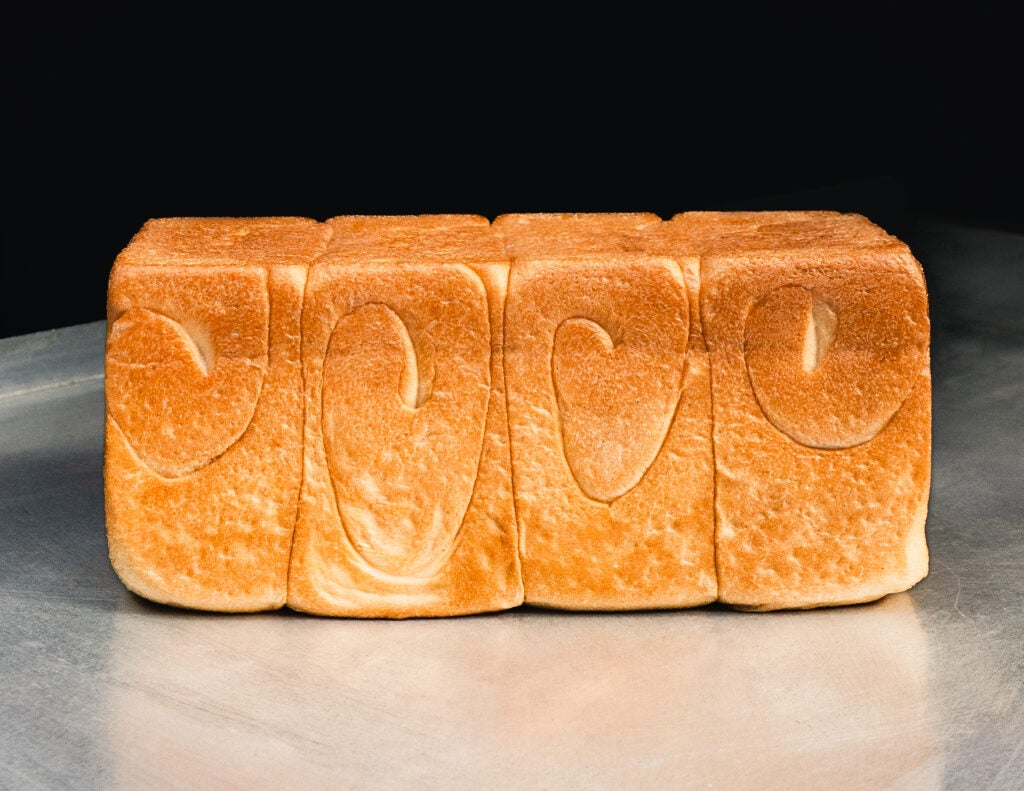
Panadera’s pandesal loaf. Photo: Carl Joel
Panadera’s signature sando is a corned beef hash with house-made garlic aioli and calamansi ketchup, pressed between slightly sweet, toasted yet tender pandesal slices instead of plain white bread or the traditional pandesal bun. “Every version of pandesal is different,” Maglanoc says, emphasizing that she’s not too bothered by negative comments about authenticity that come her way. “This is just my version. It’s not your version, your mom’s, your tita’s, or how it is in Cebu. It’s how you get it here in London, in Soho.”
With a vast Filipino diaspora estimated to reach 12 million across the globe, it only makes sense that there should be so many new and varying interpretations of what a Filipino bakery looks like.
Even in the Philippines, chefs like Jordy Navarra of the award-winning Makati City restaurant Toyo and Panaderya Toyo are experimenting with form. One of Navarra’s original creations is the bulkan—named with the Filipino word for “volcano”—made with layers of laminated dough coiled to form seismic peaks that mimic the cone-shaped Mount Mayon, a natural wonder considered sacred in Filipino mythology.
“We’re not trying to replace what already exists. Those are classics for a reason. Instead we build on them,” says Navarra. “It’s a way of saying that Filipino flavors and traditions are alive, evolving, and also capable of surprising us again and again.”
Navarra only hopes that one day we might find a word to define Filipino café culture, a term that is distinctly ours, “much like how the Swedes have ‘fika’ or Japan has kissatens.” Until then, I’ll be parked at a table at Kora, sipping on my usual salted coconut jam latte while enjoying a Spam and pimiento cheese pain Suisse.